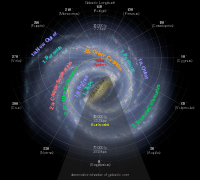
Photo from wikipedia
In the present study, the northward-propagating intraseasonal oscillations (ISOs) over the South China Sea (SCS) during the summer monsoon season are divided into two types. One is the northward propagation… Click to show full abstract
In the present study, the northward-propagating intraseasonal oscillations (ISOs) over the South China Sea (SCS) during the summer monsoon season are divided into two types. One is the northward propagation of ISOs confined in the SCS (defined as P1-ISO), another for ISOs moving from the SCS to Southern China (SC) defined as P2-ISO. The spatial and temporal structures of the two types of ISOs are compared based on the analysis of the NCEP–NCAR reanalysis datasets. It is found that a significant difference appears in the heat flux anomalies over SC that is attributed to the cloud-radiation effect. A mechanism associated with the changes in the convective instability is proposed to understand the cause of the northward propagation of the ISO from the SCS to SC. For the P1-ISO, a more precipitation over SC leads to a less surface solar radiation and then a cold land surface temperature (LST), which induces an increase of static stability via surface longwave radiation and sensible heat flux. Whereas the total contribution to the convective instability changes does create an unfavorable for ISOs propagating northward, the moisture convergence, mainly controlled by the baroclinic vorticity advection effect, may contribute to an increase of convective instability that favors the ISOs moving northward. For the P2-ISO, a less precipitation over SC results in a more shortwave radiation reaching the ground that induces a warm LST, and thus leading to a warm low-level air temperature and destabilizing the atmosphere ahead of the convection. Moreover, the moisture convergence, dominated by the warm low-level air temperature, also contributes to the increase of convective instability. Thus the convective instability increment should favor the ISOs moving northward. It is worth noting that the baroclinic vorticity advection and moisture advection are not essential for ISOs propagating from the SCS to SC.
Journal Title: Climate Dynamics
Year Published: 2020
Link to full text (if available)
Share on Social Media: Sign Up to like & get
recommendations!